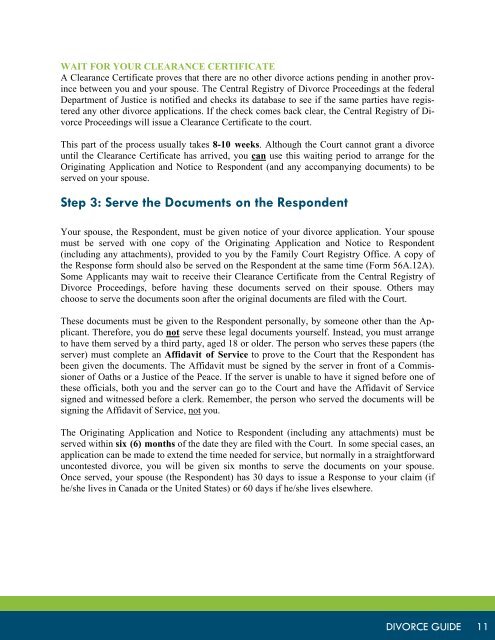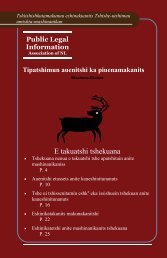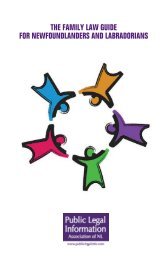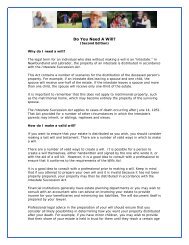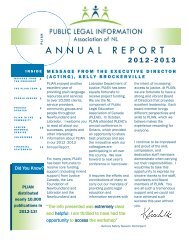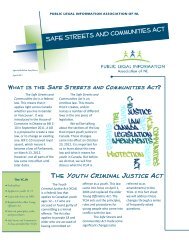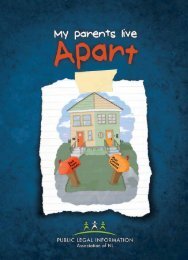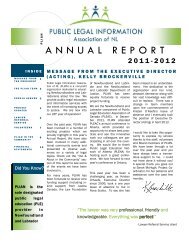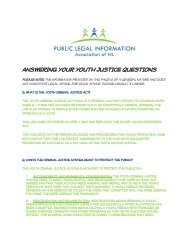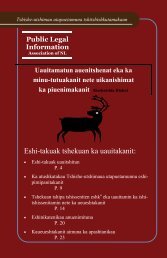Uncontested Divorce - Public Legal Information » Association of NL
Uncontested Divorce - Public Legal Information » Association of NL
Uncontested Divorce - Public Legal Information » Association of NL
Create successful ePaper yourself
Turn your PDF publications into a flip-book with our unique Google optimized e-Paper software.
WAIT FOR YOUR CLEARANCE CERTIFICATE<br />
A Clearance Certificate proves that there are no other divorce actions pending in another province<br />
between you and your spouse. The Central Registry <strong>of</strong> <strong>Divorce</strong> Proceedings at the federal<br />
Department <strong>of</strong> Justice is notified and checks its database to see if the same parties have registered<br />
any other divorce applications. If the check comes back clear, the Central Registry <strong>of</strong> <strong>Divorce</strong><br />
Proceedings will issue a Clearance Certificate to the court.<br />
This part <strong>of</strong> the process usually takes 8-10 weeks. Although the Court cannot grant a divorce<br />
until the Clearance Certificate has arrived, you can use this waiting period to arrange for the<br />
Originating Application and Notice to Respondent (and any accompanying documents) to be<br />
served on your spouse.<br />
Step 3: Serve the Documents on the Respondent<br />
Your spouse, the Respondent, must be given notice <strong>of</strong> your divorce application. Your spouse<br />
must be served with one copy <strong>of</strong> the Originating Application and Notice to Respondent<br />
(including any attachments), provided to you by the Family Court Registry Office. A copy <strong>of</strong><br />
the Response form should also be served on the Respondent at the same time (Form 56A.12A).<br />
Some Applicants may wait to receive their Clearance Certificate from the Central Registry <strong>of</strong><br />
<strong>Divorce</strong> Proceedings, before having these documents served on their spouse. Others may<br />
choose to serve the documents soon after the original documents are filed with the Court.<br />
These documents must be given to the Respondent personally, by someone other than the Applicant.<br />
Therefore, you do not serve these legal documents yourself. Instead, you must arrange<br />
to have them served by a third party, aged 18 or older. The person who serves these papers (the<br />
server) must complete an Affidavit <strong>of</strong> Service to prove to the Court that the Respondent has<br />
been given the documents. The Affidavit must be signed by the server in front <strong>of</strong> a Commissioner<br />
<strong>of</strong> Oaths or a Justice <strong>of</strong> the Peace. If the server is unable to have it signed before one <strong>of</strong><br />
these <strong>of</strong>ficials, both you and the server can go to the Court and have the Affidavit <strong>of</strong> Service<br />
signed and witnessed before a clerk. Remember, the person who served the documents will be<br />
signing the Affidavit <strong>of</strong> Service, not you.<br />
The Originating Application and Notice to Respondent (including any attachments) must be<br />
served within six (6) months <strong>of</strong> the date they are filed with the Court. In some special cases, an<br />
application can be made to extend the time needed for service, but normally in a straightforward<br />
uncontested divorce, you will be given six months to serve the documents on your spouse.<br />
Once served, your spouse (the Respondent) has 30 days to issue a Response to your claim (if<br />
he/she lives in Canada or the United States) or 60 days if he/she lives elsewhere.<br />
1<br />
DIVORCE GUIDE 11


